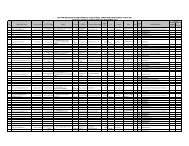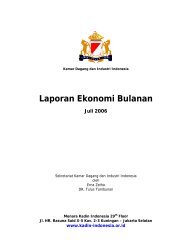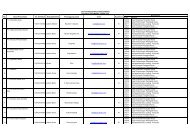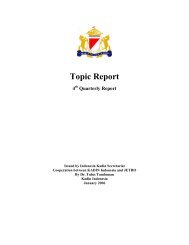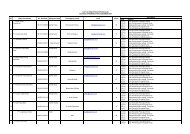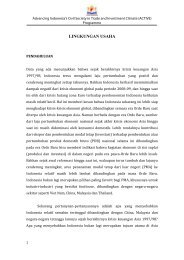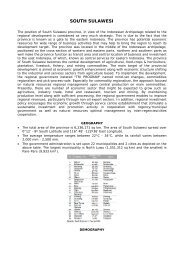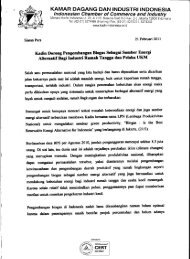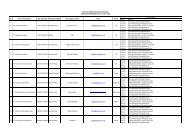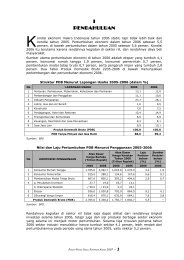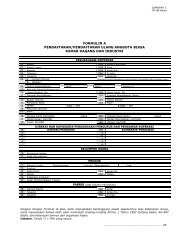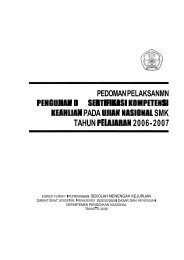Global Economic Outlook and Strategy - Kadin Indonesia
Global Economic Outlook and Strategy - Kadin Indonesia
Global Economic Outlook and Strategy - Kadin Indonesia
Create successful ePaper yourself
Turn your PDF publications into a flip-book with our unique Google optimized e-Paper software.
February 28, 2008<br />
<strong>Global</strong> <strong>Economic</strong> <strong>Outlook</strong> <strong>and</strong> <strong>Strategy</strong><br />
SNB’s 2% target ceiling. Therefore, the SNB will likely keep rates on hold in coming<br />
months, unless the CHF rises more sharply. The outlook for the CHF also should be<br />
reinforced by the currency’s longst<strong>and</strong>ing safe-haven status, with a strong <strong>and</strong> positive<br />
correlation between equity market volatility <strong>and</strong> the trade-weighted CHF.<br />
While the Norges Bank has recently expressed concerns about money market strains<br />
<strong>and</strong> heightened global economic uncertainty, we still expect further monetary policy<br />
tightening to combat inflation risks amid heightened capacity pressures <strong>and</strong><br />
accelerating wages. Oil prices are a double-edged sword for the NOK. Recent high<br />
prices have supported the NOK, but the sharp rise over the past year also raises the<br />
risk of a correction. In Sweden, the Riksbank is expected to keep rates steady near<br />
term, following the surprise rate hike in February. The next move is likely to be a cut<br />
around yearend to offset the negative effects from the credit crisis <strong>and</strong> weakening U.S.<br />
<strong>and</strong> global economic growth. But interest rate spreads remain in the SEK’s favor.<br />
Also, while periods of financial instability normally do not favor the SEK, the SEK<br />
should strengthen again once the dust settles in financial markets.<br />
Currencies across CEEMEA continue to feel the effects of conflicting forces. Amid<br />
ongoing financing concerns, currencies of external deficit countries such as South Africa<br />
<strong>and</strong> Romania remain under pressure relative to the EUR. Inflationary pressures across the<br />
region, however, continue to put upward pressure on domestic interest rates, providing<br />
some support to currencies of countries with better economic prospects, including Pol<strong>and</strong>,<br />
Israel, <strong>and</strong> Slovakia. Slovakia is also experiencing capital inflows in anticipation of a<br />
revaluation of the koruna’s central parity against the EUR next quarter as part of the euroadoption<br />
process. Hungary, by ab<strong>and</strong>oning its b<strong>and</strong>, reversed much of its January selloff.<br />
Latin American currencies have so far shown no vulnerability to deteriorating global<br />
prospects. In fact, with the United States cutting rates <strong>and</strong> commodity prices making<br />
new highs, Latin currencies have continued to appreciate. Inflationary challenges in<br />
Chile, Peru, <strong>and</strong> Colombia will likely keep those central banks vigilant, with a bias<br />
toward maintaining a hawkish discourse, <strong>and</strong> possibly even hiking rates. Rate cuts are<br />
likely in Mexico, but not until September, given the likelihood that yearly inflation will<br />
increase above the top of Banxico’s b<strong>and</strong> during most of the second quarter.<br />
Figure 20. Currency Recommendations, as of Feb 28, 2008<br />
Current<br />
3-Month<br />
Forecast<br />
Annual Return vs<br />
FWD Implied Vol.<br />
12-Month<br />
Forecast<br />
Annual Return vs<br />
FWD Implied Vol.<br />
United States NA NA NA NA NA NA NA<br />
Japan 106 105 1.9 10.7 112 -7.2 9.6<br />
Euro Area 1.51 1.52 4.1 9.1 1.46 -2.1 8.8<br />
Canada 0.98 1.02 -14.4 11.6 1.04 -5.2 10.9<br />
Australia 0.94 0.94 3.5 13.1 0.89 -0.7 12.7<br />
New Zeal<strong>and</strong> 0.81 0.80 -6.3 14.8 0.74 -3.6 14.8<br />
Norway 5.20 4.92 25.3 12.2 4.94 8.2 11.8<br />
Sweden 6.20 6.02 13.0 11.8 6.35 -0.5 11.3<br />
Switzerl<strong>and</strong> 1.06 1.05 4.7 10.0 1.03 2.7 9.0<br />
United Kingdom 1.98 1.96 -1.7 8.6 1.93 -0.4 8.5<br />
China 7.11 7.02 -5.2 3.4 6.62 -2.2 4.9<br />
India 39.9 38.7 12.7 6.0 37.2 7.7 6.4<br />
Korea 938 960 -8.8 5.3 887 6.0 4.9<br />
Pol<strong>and</strong> 2.33 2.39 -7.6 11.0 2.43 -0.7 10.5<br />
Russia 24.1 24.0 3.7 5.9 24.5 1.4 6.7<br />
South Africa 7.56 7.83 -5.5 19.6 8.07 2.2 19.3<br />
Turkey 1.18 1.23 -3.9 14.1 1.31 1.9 16.2<br />
Brazil 1.67 1.80 -23.7 13.6 1.83 -2.6 14.6<br />
Mexico 10.7 10.9 -2.3 5.3 11.0 1.6 6.6<br />
Source: Citi.<br />
15




